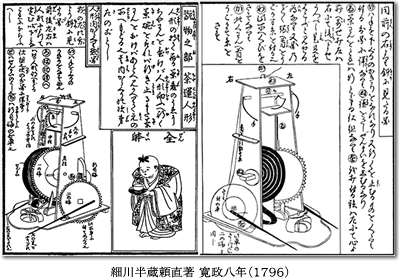Hosokawa Hanzo Yorinao of Tosa (modern-day Kōchi-ken in Shikoku) published this work in 1796 (8th year of the Kansei era). The work consists of three volumes. The first volume details the construction of mechanical clocks, while the second and third volumes contain detailed information such as diagrams of Karakuri dolls powered by springs and spindles. The work is considered the most important scholarly text on mechanical engineering of the Edo period. Even on a global scale, this was a remarkably advanced treatise on mechanics for the time.

Published by Kanchūsen Tagaya in 1730. A doctor of herbal medicine in Kyoto, he also dabbled in mathematics and gadget making. This book consists of three volumes entitled Pine, Bamboo, and Plum. Pine is the first volume and contains images of 27 different types of Karakuri dolls, drawn in picture scroll (emaki) style. The true genius of the work is to be found in the Bamboo and Plum volumes, which contain detailed explanations and diagrams explaining all of the secrets of Karakuri. The volumes contain Karakuri models such as the “Flute Playing Boy”, “Drummer Karakuri”, “Lumberjack Karakuri”, “Writing Karakuri”, and “Acrobat Doll”. Even in the diagrams a strong sense of magic or trickery prevails. 32 types of Karakuri dolls are introduced in the Bamboo and Plum volumes of the work.
